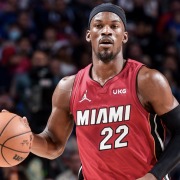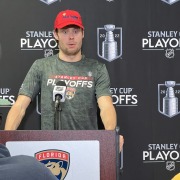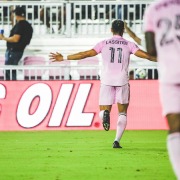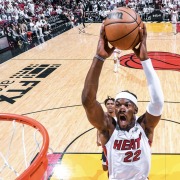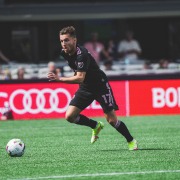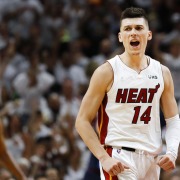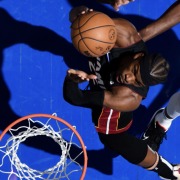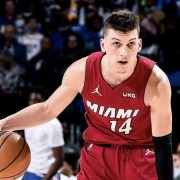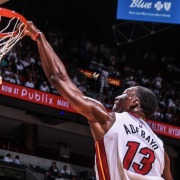Five Takeaways from Heat’s Closeout Win in Game 6 vs Philly
The Miami Heat are in the Eastern Conference Finals.
Behind Max Strus and Jimmy Butler in game 6, the Heat ran away with the game to come away with the win.
But the true factor: the defensive masterclass from Bam Adebayo and Erik Spoelstra exclusively.
Anyway, here are some takeaways from this closeout win…
#1: Max Strus entering the conversation: the illustrated definition of a rhythm player.
Walking away from game five’s domination from the Miami Heat, there was one thing that heavily stuck in my mind heading into game 6: Max Strus’ performance wasn’t just a needed night in front of the home crowd. It was a rhythm builder moving forward. The role players have been a predictable trend in this series, where the home crowd basically boosts them to another level, while the road role guys struggle majorly. And well, Strus was the headliner to breaking that trend. We can talk about sets being run for him such as the normal pin-downs, but he was the key to the opening unit clicking. Out of the PnR against drop, they need to work that drive and kick with that release valve shooter, and Strus was just that. He also had some nice drives off the move to bend the defense, which is very promising for both this team and him individually.
#2: The Heat’s notable adjustments early on.
Aside from Erik Spoelstra finger pointing, the defensive approach from game 5 carried into game 6. They weren’t switching everything, meaning there was a good mix of drop coverage to keep Bam Adebayo as the fronting man on Joel Embiid. This doesn’t just go for Bam/Embiid though. The Heat are doing the same exact thing off the ball, leading to Miami planting Butler on Maxey and fighting through screens. Now, the adjustment we’ve seen is that they found a counter to the mismatch hunting. With Thybulle in for the injured Green, Herro found himself planted on Thybulle in the weak-side corner a bunch. But like they usually do, they immediately send him up as a screener to pick on Herro. The Heat’s adjustment: blitzing those sets. Herro immediately got his hands on a Harden pass for a bucket since it surprised, but even if the pass was made, Thybulle wasn’t a threat. While the talk is all about Embiid, they had a good defensive set-up in that first half.
#3: The Tyler Herro shift.
Tyler Herro has been through blitzing as a PnR ball handler. He’s been doubled as an off-ball threat. He’s been blanketed in corners as a spacer. So well, what was the next card to play? They could’ve just continued letting the other 4 attack in space, but it seemed like Spoelstra found something early after a Max Strus dish on the wing. They were going to get Herro off the move a lot more, specifically off curls to give him a runway off the catch. He rubs shoulders with Adebayo as he gets to the top of the key, and Strus leads the pass. Herro doesn’t slow down, and gets to the basket while finishing with the left hand. There were a lot of factors to the Heat’s offense clicking on the road in this game, but I’d like to state that Herro finding his way while not being the flashy offensive threat is important. He wasn’t usual scoring Herro, but he was the focus that got others going.
#4: Bam Adebayo doesn’t care about your box score opinions.
Aggression. Shot attempts. Scoring. It’s something that’s always linked to Bam Adebayo, and sometimes for good reason as I point that stuff out plenty of times along the ride. But right now, he can transcend a 0 point number in the scoring column. That’s how absolutely elite he has been defensively. It’s been a series of constant turns for Miami’s defensive approach. No Embiid in games 1 and 2 meant they went to a bunch of switching all over the place, bothering James Harden. Games 3 and 4 ended in losses, but nothing came easy for Embiid, as Adebayo was looming as a helper after switching out yet again. Then game 5 hit. No more Bam switching, just drop, contains, and rotations. Looking at tonight specifically with that scheme carrying over, he carried over dominance. His clamps on the perimeter make highlights, but his fronting and contests on bigs like Embiid don’t get enough credit. Butler is the series’ story-line, but Adebayo deserves his flowers.
Loading...
#5: The Miami Heat find themselves in another Eastern Conference Finals.
The Miami Heat are sitting in the Eastern Conference Finals, essentially meeting the expectations that the regular season provided. Not that this is the ceiling, but the floor has been reached. Anything less than this would’ve been a disappointment, but now it’s time to make that final push. Kyle Lowry’s battled injuries. Jimmy Butler has been a top 2 player in this post-season and I’m not sure he’s 2. Bam Adebayo has taken over defensively to make any offense scared to face. Tyler Herro’s skill-set has scared opponents so much that they’re placing all of the focus onto him. The role players have shown up: Max Strus, Gabe Vincent, PJ Tucker, and many others that have contributed. And lastly, Erik Spoelstra has put together a masterclass of a game-plan: first stifling Trae Young in unthinkable manners and now bothering Joel Embiid and crew to this degree. But now they’re here, waiting to see if it is indeed the Milwaukee Bucks that they face yet again. It’s 1-1 over the last two season. This will be the true test.
For business window graphics, interior office signage, custom flags, custom banners and sign repair, reach out to SignsBrowardFortLauderdale
